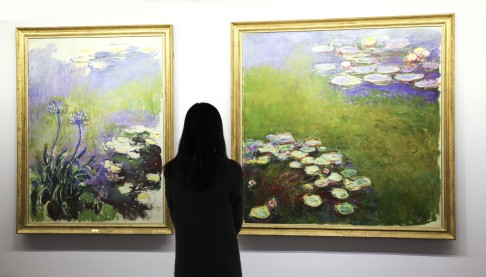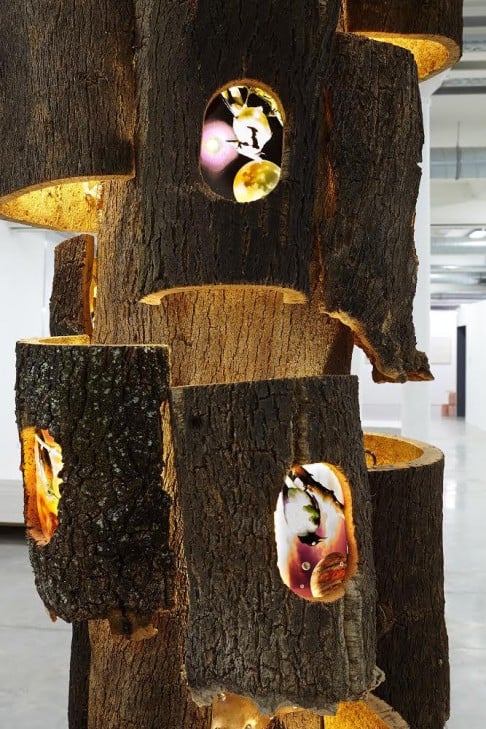
How New World heir Adrian Cheng combines his passion for art with entrepreneurship
In the first in a series on influential figures in Hong Kong's cultural scene, businessman and arts patron Adrian Cheng tells Enid Tsui how he juggles his many roles

Art Basel has returned, and the local art community has emerged from hibernation to launch a whirlwind of activity: commercial galleries, non-profit art spaces and art market publications are flagging up new projects, eager to capture the attention of the tens of thousands who visit the Hong Kong edition of the world's biggest modern and contemporary art fair.
In the middle of all of this is Adrian Cheng Chi-kong. The 35-year-old scion of one of Hong Kong's wealthiest families is both a sought-after patron as well as an eager promoter of his own art shows. And he is everywhere. Although he's just been made executive vice-chairman of New World Development - he is now the number two in a company that earned HK$5.9 billion in the past six months, according to the latest financial results - Cheng has found time to be involved in six exhibitions.during Art Basel week.
He has help, of course. "Twenty", the solo exhibition of mischievous Chinese artist Xu Zhen that opens at PMQ today is co-presented with David Chau, the Shanghai-based art collector and curator. "Inside China - L'Intérieur du Géant", which opens at the K11 Art Foundation Pop-up Space in Sheung Wan's Cosco Tower on Wednesday, is a collaboration with Palais de Tokyo in Paris.
Nonetheless, the grandson of Cheng Yu-tung, the 71st richest person on the planet with a net worth of about US$14 billion according to Forbes, has proven himself to be a self-made man in the global art world despite having an onerous day job.
He says his art-related work only takes place after office hours or at weekends.
"Every Sunday, for four hours, we talk about strategies for the Art Foundation because I only have that time," he says in his office on the 40th floor of New World Tower in Central.
Cheng is sitting on a couch in front of a David Hockney painting on the wall - one of few established names he has in a collection dominated by emerging artists. A recently adopted low-fat, no-carb diet doesn't seem to have dented his energy level.
"As the founder of K11 Art Malls and the K11 Art Foundation, I have this vision of creating a new ecosystem for the contemporary Chinese art world," he says enthusiastically, the family's signature downward-sloping eyebrows looking particularly dramatic when he emphasises a point.
It is not uncommon for Hong Kong's wealthy to be great collectors of art, but the Chengs do not appear to be such a family. Asked if his father or grandfather have any interest in art, he says: "I have no clue."
The East Asian Studies graduate from Harvard developed his passion for art as a student abroad. Before working briefly as an investment banker in the early 2000s, he studied Japanese art and culture in Kyoto for a year. After that, he lived in Beijing for two years before joining the family business, and that's when the idea of becoming a mover and shaker in the art world took root.

"I came to know a lot of people in China's art community. Back then it was very fragmented. There still wasn't a lot of galleries, and most artists came from traditional art schools. But it was a good experience. I realised what the entire scene was lacking," he says.
He also saw a chance to inject what he calls "cultural entrepreneurship" into the family empire that spans real estate, jewellery, transport and gaming. In 2008, he opened the K11 shopping mall in Tsim Sha Tsui - which claims to be the world's first art mall - with its own collection of contemporary art on display alongside temporary exhibits.
He replicated the strategy for raising footfalls in Shanghai (a Monet exhibition last year attracted long queues to view the master Impressionist's works) and other developers followed suit. Seven years later, he has made it on to the Art Review's "Power 100" ranking of influential figures in the art world. (A museums expert says Cheng is seen abroad as someone with the potential to become a major donor.)
Cheng also has a place among the top echelon of the art establishment: he is on the boards of the West Kowloon Cultural District (WKCD) and the National Museum of China Foundation, the visiting committee of the Metropolitan Museum of Art's Asian art department, the Tate's Asia Pacific acquisitions committee and the International Circle of Centre Pompidou.
It is quite an ascent for someone who started collecting just five years ago, and it is a rare demonstration of just how potent a force local business people can be if they put their minds to helping the art scene.
It's not that Hong Kong companies ignore artists: Swire and Hong Kong Land have had a long history of commissioning local artworks and dedicating grade A office space for exhibitions. Many others are important sponsors of events and non-governmental organisations, giving not just money, but time.
But Cheng's model is different. He has harnessed his family's enormous clout and poured it into an ambitious, vertically integrated operation that brings together artists, curators and museums from around the world.
I have this vision of creating a new ecosystem for the contemporary Chinese art world
The flagship of his art ventures is the non-profit K11 Art Foundation. It runs art villages in the mainland to nurture young artists, offers international scholarships and hosts exhibitions around the world. It is largely as the head of the foundation that Cheng has gained prominence as a promoter of contemporary art.
The way he juggles his business and public roles is both a mystery and a rather disquieting reminder of the reach of Hong Kong's business elite. Apart from being a senior executive at New World group and Chow Tai Fook, he is a director of 56 local companies, according to his declaration of interests as a member of the WKCD. These include Giordano and Modern Media, the company that publishes the Chinese edition of Art Newspaper. Through their non-profit organisation Arts in Heritage Research, Cheng and Calvin Hui, a co-director of Fine Art Asia, also put in a bid to run the Central Police Station revitalisation project.
There are also many non-art-related public roles, such as being a member of the Tianjin Municipal Committee of the Chinese People's Political Consultative Conference and the chairman of China Young Leaders Foundation.
Meanwhile, Cheng has just taken on yet another new role at the cultural district - to help decide what public art to display in the open space.
Does he have a massive army of art specialists at his beck and call?

"No. There are around 20 people in the company helping me with the art stuff, including a couple of K11 Art Foundation employees," he says.
That doesn't include the team behind the K11 Art Malls, however, which has enjoyed double-digit growth in revenue the past year - although how much that has to do with the art is difficult to quantify.
For the mall in Hong Kong, there are other attractive aspects - the locations, the layout and funky offerings of design products. It could also be doing well because of the underlying demand for products sold by the usual chain stores that dominate high-end malls. The Shanghai property, by comparison, is said to feature art more prominently.
Regardless of how much culture shoppers take away with them, the money that they spend is certainly helping the Chinese art scene - funding for Cheng's K11 Art Foundation comes from the malls' profits.
His multiple roles have made him an important arbiter of taste. There will always be detractors who are uncomfortable with the idea of merging art with retail, particularly when there is a growing backlash against the volume of banal, decorative art riding the wave of a still-bullish contemporary art market.
Cheng is happy to display "approachable" art in his shopping malls because of the nature of the audience, and leave the more "serious" art to his foundation. The malls make a great platform for getting ordinary people to let art into their daily lives, he says.
"The malls have the audience, the space and the money - three things that are often most lacking in the art world."
This week, for example, the Shanghai K11 will launch a multimedia exhibition of artists Cheng Ran and Chen Wei throughout the property. In Hong Kong, there will be a K11 pop-up store selling commercial products designed by renowned Chinese artist Xu Bing.
"It is a mixture of incubating art and grooming an audience who are not very familiar with art," he says. "It's to do with giving a museum experience and guidance in art appreciation to the layman."
Keeping everyone in the value chain happy will require some deft footwork. But behind the boyish face is an ambitious, driven man. Cheng has carved out a unique niche for himself in the art market and in so doing, has changed Hong Kong's opinion of what a businessman can bring to the art world.